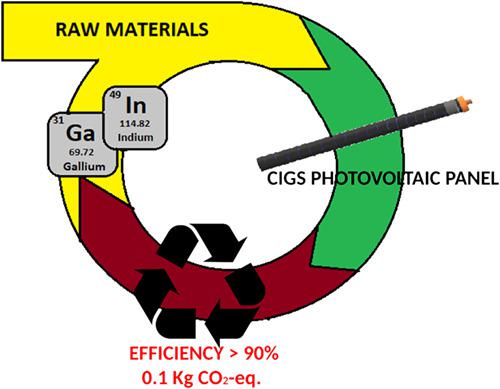当前位置:
X-MOL 学术
›
Prog. Photovoltaics
›
论文详情
Our official English website, www.x-mol.net, welcomes your
feedback! (Note: you will need to create a separate account there.)
End‐of‐life CIGS photovoltaic panel: A source of secondary indium and gallium
Progress in Photovoltaics ( IF 8.0 ) Pub Date : 2018-10-18 , DOI: 10.1002/pip.3082 Alessia Amato 1 , Francesca Beolchini 1
Progress in Photovoltaics ( IF 8.0 ) Pub Date : 2018-10-18 , DOI: 10.1002/pip.3082 Alessia Amato 1 , Francesca Beolchini 1
Affiliation

|
The photovoltaic market has boomed in the last decade, and it is becoming much richer of high performance technologies. The copper indium gallium selenide (CIGS) panel represents an example of young technology that shows high energy efficiency, kept at extreme weather conditions. Its average lifetime is around 25 years, and a strategy for a convenient recycling should be planned to prevent the future storage of high waste amount. The interest of end‐of‐life CIGS panels is due to their content of critical raw materials, mainly Ga and In, with concentrations around 600 and 90 ppm, respectively, higher than those in the ores. In this context, we tested different leaching agents (H2SO4, HCl, HNO3, citric acid, and NaOH), in the possible presence of a mobilizing agent (H2O2 and glucose), to obtain high‐efficiency metal extraction. Furthermore, to minimize the environmental impact of the process, the experimental activity was combined with the evaluation of the carbon footprint of the experimented options, using the life cycle assessment tool. Overall, the combination of CA and H2O2 appeared the best choice, from both the operative and the sustainability point of view, showing efficiencies higher than 90%, after 1 hour, at 80°C, with a carbon footprint of 0.1‐kg CO2‐eq. The obtained result represents an innovation in the field of end‐of‐life CIGS photovoltaic panel exploitation, and it is the starting point for both secondary In and Ga production, in agreement with the circular economy approach.
中文翻译:

报废的CIGS光伏电池板:铟和镓的次级来源
在过去的十年中,光伏市场蓬勃发展,并且高性能技术正变得越来越丰富。硒化铜铟镓(CIGS)面板代表了一种年轻技术的示例,该技术在极端天气条件下保持高能效。它的平均寿命约为25年,因此应计划采取便利的回收利用策略,以防止将来存储大量废物。报废CIGS面板之所以受到关注,是因为它们的关键原材料(主要是Ga和In)的含量分别比矿石中的高,分别约为600 ppm和90 ppm。在这种情况下,我们测试了不同的浸出剂(H 2 SO 4,HCl,HNO 3,柠檬酸和NaOH),并在可能存在迁移剂(H 2 O 2和葡萄糖)的情况下获得高效的金属萃取。此外,为了使过程对环境的影响最小化,使用生命周期评估工具将实验活动与对实验方案碳足迹的评估相结合。总体而言,从操作和可持续性的角度来看,CA和H 2 O 2的组合似乎是最佳选择,在80°C下放置1小时后,其效率超过90%,碳足迹为0.1-千克CO 2-eq。所获得的结果代表了CIGS光伏电池板报废开发领域的一项创新,并且与循环经济方法相一致,这是二次生产In和Ga的起点。
更新日期:2018-10-18
中文翻译:

报废的CIGS光伏电池板:铟和镓的次级来源
在过去的十年中,光伏市场蓬勃发展,并且高性能技术正变得越来越丰富。硒化铜铟镓(CIGS)面板代表了一种年轻技术的示例,该技术在极端天气条件下保持高能效。它的平均寿命约为25年,因此应计划采取便利的回收利用策略,以防止将来存储大量废物。报废CIGS面板之所以受到关注,是因为它们的关键原材料(主要是Ga和In)的含量分别比矿石中的高,分别约为600 ppm和90 ppm。在这种情况下,我们测试了不同的浸出剂(H 2 SO 4,HCl,HNO 3,柠檬酸和NaOH),并在可能存在迁移剂(H 2 O 2和葡萄糖)的情况下获得高效的金属萃取。此外,为了使过程对环境的影响最小化,使用生命周期评估工具将实验活动与对实验方案碳足迹的评估相结合。总体而言,从操作和可持续性的角度来看,CA和H 2 O 2的组合似乎是最佳选择,在80°C下放置1小时后,其效率超过90%,碳足迹为0.1-千克CO 2-eq。所获得的结果代表了CIGS光伏电池板报废开发领域的一项创新,并且与循环经济方法相一致,这是二次生产In和Ga的起点。











































 京公网安备 11010802027423号
京公网安备 11010802027423号